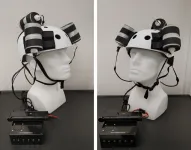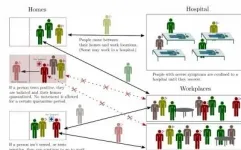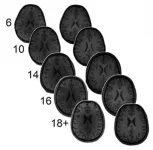INFORMATION:
The study was co-authored by Ellen Cowan of Appalachian State University, and by Rachel Coyte, Heather Stapleton and Gary Dwyer, all of Duke. Support came from the National Science Foundation and from Mooresville, N.C., community funding, led by Susan Wind, a former resident.
CITATION: "Evaluation and Integration of Geochemical Indicators for Detecting Trace Levels of Coal Fly Ash in Soils," Zhewn Wang. Rachel M. Coyte, Ellen A. Cowan, Heather M. Stapleton, Gary S. Dwyer and Avner Vengosh; Environmental Science & Technology, July 20, 2021. DOI: 10.1021/acs.est.1c01215
New tests can detect tiny but toxic particles of coal ash in soil
Test finds ash at concentrations so low and sizes so small that other tests would likely miss it
2021-07-22
(Press-News.org) DURHAM, N.C. - Scientists at Duke University have developed a suite of four new tests that can be used to detect coal ash contamination in soil with unprecedented sensitivity.
The tests are specifically designed to analyze soil for the presence of fly ash particles so small other tests might miss them.
Fly ash is part of coal combustion residuals (CCRs) that are generated when a power plant burns pulverized coal. The tiny fly ash particles, which are often microscopic in size, contain high concentrations of arsenic, selenium and other toxic elements, many of which have been enriched through the combustion process.
While the majority of fly ash is captured by traps in the power plant and disposed to coal ash impoundments and landfills, some escapes and is emitted into the environment. Over time, these particles can accumulate in soil downwind from the plant, potentially posing risks to environment and human health.
"Because of the size of these particles, it's been challenging to detect them and measure how much fly ash has accumulated," said Avner Vengosh, Distinguished Professor of Environmental Quality at Duke's Nicholas School of the Environment. "Our new methods give us the ability to do that - with high level of certainty."
Coal combustion residuals are the largest industrial solid wastes produced in the United States. When soil contaminated with fly ash is disturbed or dug up, dust containing the ash can be transported through the air into nearby homes and other indoor environments. Inhaling dust that contains fly ash particles with high levels of toxic metals has been linked to lung and heart disease, cancer, nervous system disorders and other ill effects.
"Being able to trace the contamination back to its source location is essential for protecting public health and identifying where remediation efforts should be focused," said Zhen Wang, a doctoral student in Vengosh's lab at Duke, who led the study. "These new methods complement tests we've already developed for tracing coal ash in the environment and expand our range of investigation."
The new tests are designed to be used together to provide independent corroborations of whether fly ash particles are present in a soil sample and if so, at what proportion to the total soil.
"First, we measure the abundance of certain metals, such as arsenic, selenium and antimony, that we know are more enriched in coal ash than in normal soil," Wang said. "If these metals are present at higher-than-normal levels, we test the sample using two other geochemical indicators, radium nuclides and lead stable isotopes, which are more sensitive than trace metals and can be used to detect low occurrence of fly ash in soils. We also examine the soil under a microscope to test if we can physically identify fly ash particles and estimate what proportion of the soil they comprise."
Each method has its own strengths and weaknesses, and if used solely could lead to overestimates or underestimates the occurrence of fly in soil, Vengosh said. "By using all four together, we are able to verify the forensic investigation of fly ash presence in soils."
To assess the reliability of the new tests, the researchers analyzed surface soil from 21 sites downwind of the Tennessee Valley Authority's Bull Run Fossil Plant in Claxton, Tenn., and 20 sites downwind of Duke Energy's Marshall Steam Station on Lake Norman, N.C. The North Carolina samples came from Mooresville, a town located across the lake from the Marshall plant. Control samples were also collected at sites upwind of each plant.
The tests consistently showed that most of the samples collected downwind of both plants contained fly ash contamination, but because the proportion of the fly ash was low, the concentrations of toxic elements did not exceed human health guidelines for metals occurrence in soil.
The tests also showed that soil samples near Bull Run Fossil Plant in Tennessee generally contained significantly higher levels of fly ash than those from North Carolina, and that the highest concentration was in soil from the Claxton Community Park, a playground and recreational site located outside the Bull Run plant.
What does this all tell us?
"First, it confirms that our new tools perform consistently and, when used together, provide a reliable method for detecting contamination that other tests might miss," Vengosh said.
"Second, it underscores the need to regularly monitor sites in close downwind proximity to a coal-fired power plant, even if levels of contamination are below current safety thresholds. Fly ash accumulates over time, and risks can grow with repeat exposures to playground dust or home dust," Vengosh said.
"Low concentrations of toxic metals in soil does not equal to no risk," Vengosh said. "We need to understand how the presence of fly ash in soils near coal plants could affect the health of people who live there. Even if coal plants in the United States are shutting down or replaced by natural gas, the environmental legacy of coal ash in these areas will remain for decades to come."
The peer-reviewed study was published in July 20 in Environmental Science & Technology.
ELSE PRESS RELEASES FROM THIS DATE:
Doctoral student bridges gap between electronics and optics
2021-07-22
According to the United Nations' telecommunications agency, 93% of the global population has access to a mobile-broadband network of some kind. With data becoming more readily available to consumers, there is also an appetite for more of it, and at faster speeds.
Ramy Rady, doctoral student in the Department of Electrical and Computer Engineering at Texas A&M University, is working with Dr. Kamran Entesari, his faculty advisor and professor, and Dr. Christi Madsen, professor, to design a chip that can revolutionize the current data rate for processors and technologies such as smartphones, laptops, etc. Dr. Sam Palermo, ...
The anatomy of a planet
2021-07-22
Since early 2019, researchers have been recording and analysing marsquakes as part of the InSight mission. This relies on a seismometer whose data acquisition and control electronics were developed at ETH Zurich. Using this data, the researchers have now measured the red planet's crust, mantle and core - data that will help determine the formation and evolution of Mars and, by extension, the entire solar system.
Mars once completely molten
We know that Earth is made up of shells: a thin crust of light, solid rock surrounds a thick mantle of heavy, viscous rock, which in turn envelopes a core consisting mainly of iron and ...
'Wrapping' anodes in 3D carbon nanosheets: The next big thing in li-ion battery technology
2021-07-22
Lithium-ion batteries (LIBs), which are a renewable source of energy for electrical devices or electric vehicles, have attracted much attention as the next-generation energy solution. However, the anodes of LIBs in use today have multiple inadequacies, ranging from low ionic electronic conductivity and structural changes during the charge/discharge cycle to low specific capacity, which limits the battery's performance.
In search of a better anode material, Dr. Jun Kang of Korea Maritime and Ocean University, along with his colleagues from Pusan National University, Republic of Korea, END ...
During COVID-19, nurses face significant burnout risks, reports American Journal of Nursing
2021-07-22
July 22, 2021 - Early in the COVID-19 pandemic, more than 40 percent of nurses and other health care workers had risks associated with an increased likelihood of burnout, reports a survey study in the August issue of the American Journal of Nursing (AJN). The journal is published in the Lippincott portfolio by Wolters Kluwer.
The study identifies risk factors for poor well-being as well as factors associated with greater resilience - which may reduce the risk of burnout for hands-on care providers, according to the new research by Lindsay Thompson Munn, RN, PhD, and colleagues of a North Carolina healthcare system. They write, "The insights ...
Surrey builds AI to find anti-ageing chemical compounds
2021-07-22
The University of Surrey has built an artificial intelligence (AI) model that identifies chemical compounds that promote healthy ageing - paving the way towards pharmaceutical innovations that extend a person's lifespan.
In a paper published by Nature Communication's Scientific Reports, a team of chemists from Surrey built a machine learning model based on the information from the DrugAge database to predict whether a compound can extend the life of Caenorhabditis elegans - a translucent worm that shares a similar metabolism to humans. The worm's shorter lifespan gave the researchers the opportunity to see the impact of the chemical compounds.
The AI singled ...
Investigational magnetic device shrinks glioblastoma in first-in-world human test
2021-07-22
Houston Methodist Neurological Institute researchers from the department of neurosurgery shrunk a deadly glioblastoma tumor by more than a third using a helmet generating a noninvasive oscillating magnetic field that the patient wore on his head while administering the therapy in his own home. The 53-year-old patient died from an unrelated injury about a month into the treatment, but during that short time, 31% of the tumor mass disappeared. The autopsy of his brain confirmed the rapid response to the treatment.
"Thanks to the courage of this patient and his family, we were able to test and verify the potential effectiveness of the first noninvasive therapy ...
Cattle losing adaptations to environment, MU researchers find
2021-07-22
As a fourth-generation cattle farmer, Jared Decker knows that cattle suffer from health and productivity issues when they are taken from one environment -- which the herd has spent generations adapting to -- to a place with a different climate, a different elevation or even different grass. But as a researcher at the University of Missouri, Decker also sees an opportunity to use science to solve this problem, both to improve the welfare of cattle and to plug a leak in a nearly $50 billion industry in the U.S.
"When I joined MU in 2013, I moved cattle from a family farm in New Mexico to my farm here in Missouri," said Decker, an associate professor and Wurdack Chair in Animal Genetics at the College of Agriculture, Food and Natural Resources. "New Mexico is hot and dry, and Missouri is ...
Less-sensitive COVID-19 tests may still achieve optimal results if enough people tested
2021-07-22
A computational analysis of COVID-19 tests suggests that, in order to minimize the number of infections in a population, the amount of testing matters more than the sensitivity of the tests that are used. Philip Cherian and Gautam Menon of Ashoka University in Sonipat, India, and Sandeep Krishna of the National Centre for Biological Sciences TIFR, Bangalore, India, present their findings in the open-access journal PLOS Computational Biology.
Different states in India use different mixes of two main tests for COVID-19: a very sensitive reverse-transcriptase polymerase-chain-reaction (RT-PCR) test and a less sensitive rapid antigen test. Traditional thinking holds that an all-RT-PCR approach ...
Neurotransmitter levels predict math ability
2021-07-22
The neurotransmitters GABA and glutamate have complementary roles -- GABA inhibits neurons, while glutamate makes them more active. Published 22nd July in PLOS Biology, researchers led by Roi Cohen Kadosh and George Zacharopoulos from the University of Oxford show that levels of these two neurotransmitters in the intraparietal sulcus of the brain can predict mathematics ability. The study also found that the relationships between the two neurotransmitters and arithmetic fluency switched as children developed into adults.
Levels of brain excitement/inhibition are thought to be related to learning, especially during critical periods. However, little is known about how they are related to complex learning that can take place over decades. To address this issue, the researchers ...
Clever cockatoos learn through social interaction
2021-07-22
For the first time, a team of international scientists have proven that cockatoos, an iconic Australian bird species, learn from each other a unique skill - lifting garbage bin lids to gather food. The world-first research published today in Science, confirms that cockatoos spread this novel behavior through social learning. Led by Barbara Klump and Lucy Aplin (Max Planck Institute of Animal Behavior), along with John Martin (Taronga Conservation Society) and Richard Major (Australian Museum), the team have shown that this behavior by cockatoos is actually ...
LAST 30 PRESS RELEASES:
Anthropologists offer new evidence of bipedalism in long-debated fossil discovery
Safer receipt paper from wood
Dosage-sensitive genes suggest no whole-genome duplications in ancestral angiosperm
First ancient human herpesvirus genomes document their deep history with humans
Why Some Bacteria Survive Antibiotics and How to Stop Them - New study reveals that bacteria can survive antibiotic treatment through two fundamentally different “shutdown modes”
UCLA study links scar healing to dangerous placenta condition
CHANGE-seq-BE finds off-target changes in the genome from base editors
The Journal of Nuclear Medicine Ahead-of-Print Tip Sheet: January 2, 2026
Delayed or absent first dose of measles, mumps, and rubella vaccination
Trends in US preterm birth rates by household income and race and ethnicity
Study identifies potential biomarker linked to progression and brain inflammation in multiple sclerosis
Many mothers in Norway do not show up for postnatal check-ups
Researchers want to find out why quick clay is so unstable
Superradiant spins show teamwork at the quantum scale
Cleveland Clinic Research links tumor bacteria to immunotherapy resistance in head and neck cancer
First Editorial of 2026: Resisting AI slop
Joint ground- and space-based observations reveal Saturn-mass rogue planet
Inheritable genetic variant offers protection against blood cancer risk and progression
Pigs settled Pacific islands alongside early human voyagers
A Coral reef’s daily pulse reshapes microbes in surrounding waters
EAST Tokamak experiments exceed plasma density limit, offering new approach to fusion ignition
Groundbreaking discovery reveals Africa’s oldest cremation pyre and complex ritual practices
First breathing ‘lung-on-chip’ developed using genetically identical cells
How people moved pigs across the Pacific
Interaction of climate change and human activity and its impact on plant diversity in Qinghai-Tibet plateau
From addressing uncertainty to national strategy: an interpretation of Professor Lim Siong Guan’s views
Clinical trials on AI language model use in digestive healthcare
Scientists improve robotic visual–inertial trajectory localization accuracy using cross-modal interaction and selection techniques
Correlation between cancer cachexia and immune-related adverse events in HCC
Human adipose tissue: a new source for functional organoids
[Press-News.org] New tests can detect tiny but toxic particles of coal ash in soilTest finds ash at concentrations so low and sizes so small that other tests would likely miss it






